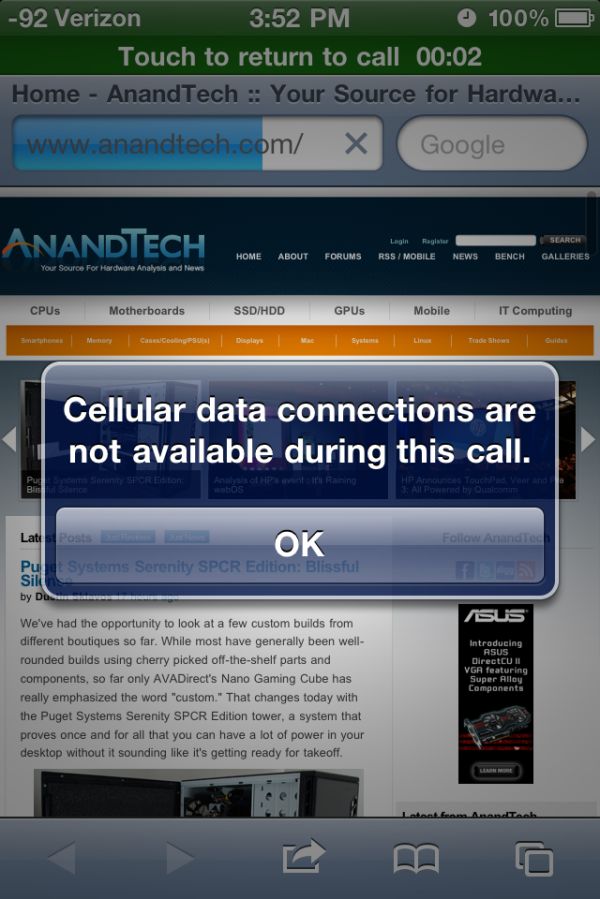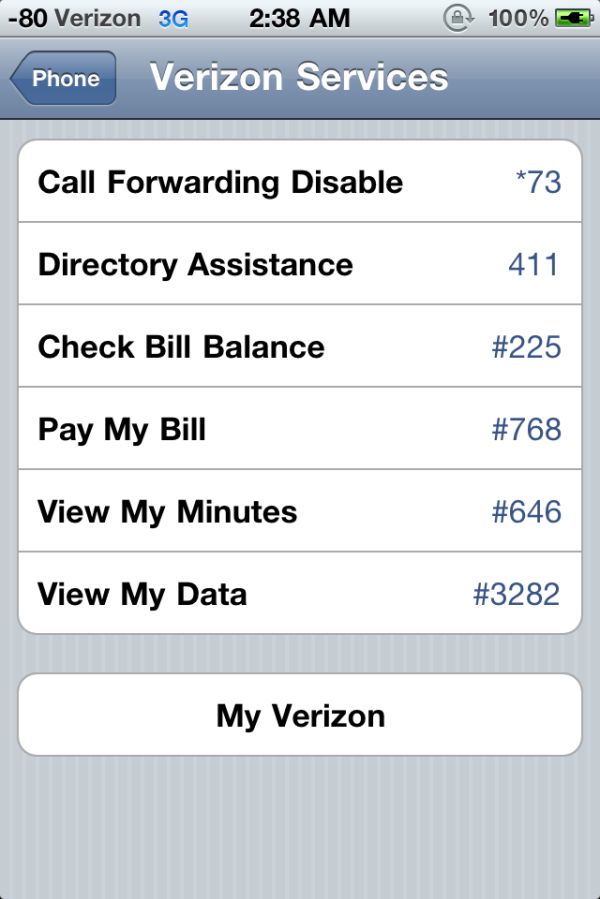Verizon iPhone 4: Thoroughly Reviewed
by Brian Klug on February 13, 2011 9:32 AM ESTSimultaneous Calls, Texts, Data
So if you've heard anything about the Verizon iPhone 4 versus the AT&T iPhone 4, you've heard about simultaneous voice and data. Truth is that on UMTS voice and data are multiplexed, and you can do them at the same time. On 1xEVDO you can either transact voice, or data, but not both at the same time. If you try to do it on the Verizon iPhone 4, you get a screen like this:
It isn't really just voice that interrupts data, however. Text messaging (SMS) does it as well. If you're surfing along and an SMS comes in, data pauses for about three or so seconds while the phone goes down to 1x, gets the SMS, then reacquires EVDO. A lot of people don't know that SMS is still over voice on the CDMA camp. If you're doing lots of texting and surfing at the same time, this can get annoying fast. If you're being bombarded with lots and lots of SMSes, you can't transact any data until all of them are done showing up. You can see behavior for yourself in our overview video as well.
There's also another set of nuances between the CDMA iPhone 4 and UMTS iPhone 4. Conference call features are different, and there are a lot of small things. Whereas the UMTS iPhone 4 can support up to five simultaneous lines, the CDMA version only supports two.
There were also toggles for call forwarding, call waiting, and caller ID toggles on the UMTS version. These are notably absent on the CDMA version, instead you'll need to enter appropriate * codes for those (*72 and *73 for forwarding, *70 for call waiting, *67 for caller ID). That's not an Apple thing but rather a network limitation.
An even larger (but oft overlooked) difference are the SMS differences between the CDMA carriers and UMTS. The CDMA SMS specification has no support for messages with characters outside of ASCII. Send or receive one with "Emoji" or other non-ASCII characters from a CDMA iPhone 4, and you'll get no alert, it just disappears.
One of the huge selling points of GSM for me personally has been long SMS support. If you routinely send texts that are over 160 characters, UMTS/GSM generally wins because most carriers implement long SMS support properly. Verizon had had its own message concatenation back in the day, but I've yet to see it really used on a smartphone of theirs. It was one of the first things I tested against a friend of mine who also has a Verizon iPhone 4. Turns out that between Verizon customers, SMS concatenation does work, and long multi-texts are combined into one. That's hugely awesome if you SMS as much as I do.
However, concatenation doesn't always work between carriers. That's not a carrier specific thing, but just crappy SMS interchanges between carriers being a problem.













35 Comments
View All Comments
shakyone - Sunday, February 13, 2011 - link
Wife got the VZ iPhone 6 days ago. I use an Android phone. After one week, I have yet to experience one dropped call of 23, since it arrived, (used Android's call Log). It is as reliable as her VZ Blackberry. The audio is as good too. My brother has an AT&T iPhone 3GS. I don't talk to him that often, but it has dropped calls on me 3 of the last 7 times I called him in the last four months. I don't have much experience with friends that have the AT&T iPhone 4G.MonkeyPaw - Sunday, February 13, 2011 - link
ATT iPhone 3G user here. I have dropped calls all the time. Doesn't matter where I am. Our other phone is a cheap T-mobile phone, and even with a cheap 2 year old flip phone, calls rarely failed. The worst that happened was poor call quality on occasion.Wiggy McShades - Sunday, February 13, 2011 - link
Where do you live? I'm in the Boston area and have never once had a dropped call using an iphone 3g and now an iphone 4. I'm pretty certain my location is why I've had such a great experience with at&t, are you not near a major city? Or is it really just luck that the area I'm in is well covered?JimmiG - Sunday, February 13, 2011 - link
That really is abysmally slow.. not fast enough to watch video at decent quality, for example. I get around 3500kbps down/1400 up in my apartment on the outskirts of town using the HTC Desire and HSDPA, faster near urban centers.I wouldn't call it a smartphone unless you get at least 2Mb, maybe 1.5Mb/s out of it, since slower speeds render many of the features unusable, limiting you to texting and maybe browsing with images turned off.
dagamer34 - Sunday, February 13, 2011 - link
Some signal is better than no signal at all.Shadowself - Sunday, February 13, 2011 - link
This is *absolutely* true. Some signal is better than none.However, as the article mentions, this is very dependent on the individual. One person may almost never experience dropped calls on AT&T due to where and when they use their phone. In such a situation that person may adamantly prefer the AT&T iPhone over the Verison model. Alternately, another person may use their phone -- even in the same city -- in locals and at times where the phone routinely drops calls due to AT&T's network issues. In this case that user would just as adamantly prefer Verison over AT&T.
My wife's personal experience is that the parking lot of her office is a true Verizon dead zone. There is virtually no detectable signal there at all even with very sophisticated equipment and large antennas. You have to move several hundred yards from her parking lot (in almost any direction) for any Verizon phone to work. Verizon has known about this dead spot for over 8 years and has yet to negotiate a new tower in the area (or modify existing towers) to fill that hole. Therefore, for her Verizon is not an option.
It all comes down to what you need and *your" use.
vol7ron - Sunday, February 13, 2011 - link
Oh no. These Verizon vs AT&T flame-wars are almost worse than the Microsoft vs Apple.At least in the later, you had a constant product difference. In service providers its subject to location. And in major cities, I've never had a problem with AT&T except in metros, where they didn't have antennas and Vzn decided to put some up and large venues where you got a lot of units in one tight area at the same time, like large conferences or concerts.
I've had just as much trouble with Verizon black spots as I've had with AT&T. It's all based on where you are and where you travel.
asandok - Sunday, February 13, 2011 - link
In ifixit's teardown they say the wi-fi antenna is what you point out to be the cell antenna. Which is it? It looks like they made a boo boo. Awesome write up though! Love these!Brian Klug - Monday, February 14, 2011 - link
Indeed, the component they pointed to and called the WiFi antenna is the first of two cellular feed lines, and that part has indeed not changed. It's for cellular (and was on the GSM/UMTS iPhone) and not WiFi. Even the FCC correctly labels it as being a feed line for cellular. WiFi has always been at the top in the same place with the same package, though the WiFi antenna did change slightly with the Verizon version.-Brian
Montrey - Sunday, February 13, 2011 - link
Funny you mention how inaudible the vibrate is. I had my Verizon iPhone on vibrate during a physics test Friday, it rang in the pocket of my jeans and my professor heard it 20 feet away and threatened to kick me out if I didn't turn off my phone. Maybe he just has superhuman hearing, I thought it was pretty quiet, especially compared to the droid eris it just replaced.